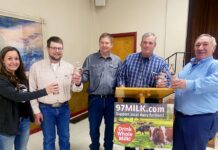“Hacker Creek Road ran for a quarter of a mile beyond our house before it was swallowed up in the deep woods.
At the side of this road, midway off the clearing, was a volunteer apple tree, one of those planted unintentionally by some passing bird or animal.
My father had let it grow, of course, to see what kind of apple it would be. It might be a brand-new variety or one that could be budded or grafted to make a new one.
I had often gone to this tree for solitude and comfort. This day, I put on my new, too-tight shoes and laced them up, and decided that if I ran from the tree to the woods and back a certain number of times, the shoes would be comfortable.
So I did that, and after that, the shoes and I were good friends. Naturally, I didn’t tell anybody or take any witnesses along for the disciplining project.”
— Rachel Peden
Part one
I have often thought what a big part the trees on our fields and farms serve as a marker for those of us who grew up in the wide-open spaces of farmland.
Sometimes the trees served as boundary markers when we were very young, allowing us to ride our tricycles or pedal tractors just to the big maple tree, and not one step beyond.
Maple tree
A bit later, that same maple tree served as our “home base” for hide and seek. The one doing the seeking was to stand, eyes closed and covered, counting to 100 at that great tree while sisters and cousins and neighbor kids scattered in search of the very best hiding spot.
“Ollie, ollie in free!” I remember calling when I just wanted to give up, in hopes of convincing everyone it was time to play a good game of baseball instead.
When that was shouted out, those hiding had the chance to dart from their secluded spots, run as fast as they could and touch that tree.
Landmarks
Often, when Dad needed one of us to bring him a packed lunch or a fresh thermos of coffee while he was working in the field, he would tell us ahead of time which tree or fencerow in a particular field we should come to, waving to him until he saw us.
Even if we were so young we had no idea what type of tree it was — an oak, a beech or a black walnut — just knowing in which field Dad would be working conjured up the picture of the tree in our mind, and we knew exactly where to go.
Of course, each field had been named by our dad, but the tree or grove of trees was often named by us running the deliveries.
When meeting up with Dad for his coffee and sandwich near the Wilderness field, I remember hiking to the wildly grown grove of trees, one so gnarled it looked like a cross.
I often sang The Old Rugged Cross at the top of my lungs while waiting for Dad to circle around and stop, knowing no one could possibly hear my singing in our very own wilderness.
It was also wise to be on the lookout for arrowheads while waiting for the tractor to come around. It seems I found more flint and arrowheads during those simple delivery jaunts than on any other field walks.
We were to later learn one large part of our farm had been a ceremonial ground for the Native Americans who came long before us.
Disappearing
As family farms become just a small part of someone’s much larger tillable acreage, much of this has been cleared, and more will continue to be.
The charm of our landmarks and the trees that have stood for generations will be leveled, never to return.
Each one is still there in my memory, but for those who come after our generation, it’s sad to think those glorious landmark trees, hundreds of years old, cannot be conjured up in any form.
The community histories, unfortunately, are being leveled as well.
Next week: Part two.













Lovely post! I’m so glad to hear about the historical significance of the old oak tree and the impact it’s had on the local community. It’s great to see farmers and dairymen coming together to share their stories and connect with each other. Can’t wait to read more from this blog!
